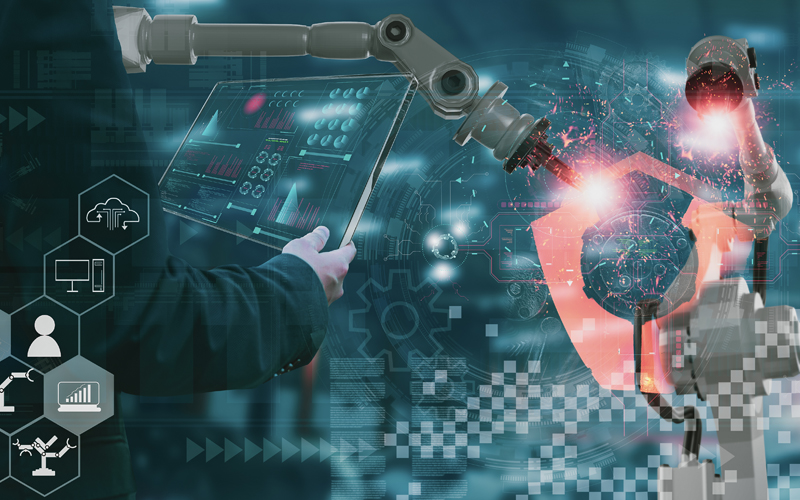Five Manufacturing Trends for 2023
An energy crisis, strikes and three Prime Ministers. 2022, like 2021 has been unpredictable. Such uncertainty has led to the manufacturing industry making up almost 8% of the total company insolvencies in England and Wales in the first half of 2022. As 2022 draws to a close, we are taking this opportunity to take stock of what has happened and share our predictions for 2023.
2023 is the year for change, and as such we predict an end to short-term thinking. Innovation takes time, much more than an elected politician’s four yearly cycle. So, what should manufacturers be focusing on to secure their businesses for the future? Here are the trends that we think you should watch out for going into 2023.
Bridging the digital and physical world
Industry 4.0 is still evolving, and the true potential of its technologies remains unknown. The future brings with it new needs and new customers. For manufacturers to remain competitive they must be agile in their approach to industrial revolutions, knowing when and how to respond to change. Efforts should move towards upskilling the current workforce to take on new work responsibilities made possible by Industry 4.0, creating a customised approach to leverage the unique circumstances, culture and values of separate factory sites.
Designers and engineers should watch out for digital twin technology and 3D printing. Digital twins are computer-generated copies of real-world processes, operations, or products that can be used to test new ideas in a safe digital environment. When applied in a manufacturing setting, we could see machinery design improvements from the factory floor which will ultimately reduce the time and cost of machinery downtime.
And by implementing new technologies such as Augmented Reality manufacturers will be able to identify errors in the earlier stages of the design process. This could reduce the number of prototypes needed to move towards the next stage of development by cutting down on the time it takes to develop a product and improve overall cost without compromising on the quality of missing a vital stage.
Leveraging your data
The evolution of Big Data involves the development of computers, smartphones, the internet and sensory (IIoT) equipment to provide data. Big Data has revolutionised entire industries, changed human culture and behaviour and even influenced the way people vote. The past decade has been a gradual merger of artificial and human intelligence and, as we edge closer to 2023, we predict the role of big data and robotic assistance to grow further for manufacturers.
Incorporating AI technology with the IIoT such as digital twins means that smart AI objects can be used anywhere and everywhere they’re needed, enabling quick decision-making to support workers across all industries.
The Industrial Internet of Things (IIoT) is a network of intelligent devices connected to form systems that monitor, collect, exchange, and analyse data. These deployed AI objects can collect information from across your factory floor and collate it into meaningful data sets. This means you can embed analytics and machine learning modules pretty much anywhere you need them, and then view the data and use it to inform meaningful change.
AI when applied to machine learning, will help to improve process learning and adapt according to its experiences. This means that not only can efficiencies be gathered in the short term, but also AI can adapt and improve into the future. This approach reduces hardware costs, and businesses remain on top of new and improved technologies.
Addressing the skills gap
Investment in technology doesn’t necessarily eliminate the need for a human workforce. One of the main misconceptions workers have with AI is that it will mean large-scale redundancies in the manufacturing sector as machines replace people. Businesses should be focusing on how they can work in unison with Industry 4.0 technologies rather than adopting an ‘us and them’ approach. A lack of international standardisation means that technology such as smart AI objects require engineers to implement as they see fit. Additionally, the introduction of AI can benefit the workforce as repetitive and time-consuming tasks that previously needed to be performed by staff can be handled by AI technology. This leaves skilled and time-poor workers to complete more cognitively challenging and interesting tasks. The Government’s research and development budget investment of £20 billion by 2024-25 will help grow the UK’s labour market allowing manufacturers to focus on upskilling the existing workforce.
Blockchain technology
The adoption of blockchain technology is expected to grow 73.6% through 2026 to a market size of $778 billion as more companies create decentralised products and services.
From an operational standpoint, using blockchain will enable manufacturers to gain greater visibility into supply chains and track assets with unprecedented precision. Implementing blockchain technology to help track factory audits could significantly help improve the lifespan of factory machinery as audits and servicing can be logged, tracked and analysed for improvements which will in turn lower financial losses and improves overall operational costs.
Switching to Green energy
The price of energy is likely to remain a key concern for businesses, especially during winter months when energy usage for many businesses increases
The Autumn Statement announcement declared that energy bills are set to increase for households and investment will be moving towards nuclear energy. This affirms the belief that all industries where possible should be switching to renewable energy. Not only will this reduce our emissions and edge us closer to the net zero target, but it will also provide energy independence as we become less reliant on the global gas market.
For 2023, manufacturers should keep an eye out for the innovations surrounding green hydrogen, a newer, cleaner source of energy that produces zero greenhouse gas emissions. Energy companies like Shell and RWE have begun to pave the way in this developing sector, creating the first major green pipeline from wind plants in the North Sea.
To learn about our technology solutions for the manufacturing sector, click here

